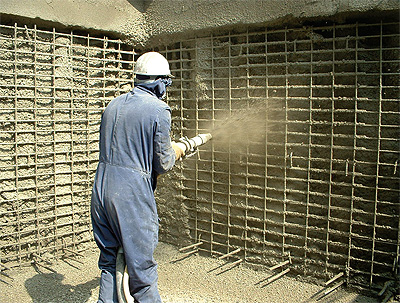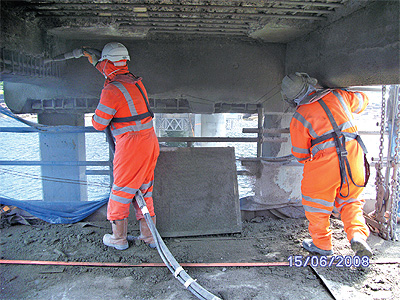The Sprayed Concrete Association
The Sprayed Concrete Association was originally formed in 1976 by a small group of leading Gunite contractors, establishing a governing body to light the future path of the trade and provide assistance and guidance to its members
Through the eye of the nozzle
The Sprayed Concrete Association was originally formed in 1976 by a small group of leading Gunite contractors, establishing a governing body to light the future path of the trade and provide assistance and guidance to its members
The multi-million pound industry has surprisingly prehistoric affiliations, with sprayed concrete technology first engineered in the US as a method of applying mortar to re-create primitive animals. Essentially, the technology supports the application of concrete without the need of shuttering, which is a standard requirement for conventional casting. The century old trade first became popular in the UK in the 1970’s, leading to the formation of the Sprayed Concrete Association (SCA) and the establishment of its key aims.
 Recently the SCA has become part of the Structural Concrete Alliance. The Alliance brings together the Concrete Repair Association, Corrosion Prevention Association and the Sprayed Concrete Association to provide a single co-ordinated voice and source of reference for the Structural Concrete refurbishment and repair industry.
Recently the SCA has become part of the Structural Concrete Alliance. The Alliance brings together the Concrete Repair Association, Corrosion Prevention Association and the Sprayed Concrete Association to provide a single co-ordinated voice and source of reference for the Structural Concrete refurbishment and repair industry.
The Structural Concrete Alliance provides authoritative guidance on asset protection and repair including:
- The repair, refurbishment and renovation of concrete
- Cathodic protection of steel and concrete structures
- Sprayed concrete technology and application techniques
Representing over 90 companies drawn nationally from contractors, manufacturers, distributors, consultants, test houses and equipment suppliers, the Alliance offers a single point of contact for major clients and a definitive source of information and advice for all involved in the repair, refurbishment and management of concrete infrastructure and the protection from corrosion of a wide range of structures.
A key aim of the Sprayed Concrete Association is the development and promotion of sprayed concrete on a national scale. The promotion of sprayed concrete is mainly communicated through numerous exhibitions, presentations, roadshows, email listings, members meetings and the SCA website. For information on all publicity events please contact the association at www.sca.org.uk or by calling 01420 471 622. The SCA has worked closely with members to develop the codes of practice and also the materials that are required to meet the advances in the technology of sprayed concrete, and ultimately provide an end product that conforms to the requirements of the specification and the client.
The production and maintenance of specification and codes of practice represents a key aim of the SCA, regulating both how sprayed concrete should be applied and who should be applying it, as Peter Cotton, SCA chairman explains: “Contractors should hold membership with the SCA. However, there are some companies that contravene these regulations, which is not beneficial for either the client or the industry. Sprayed concrete contractors and associated companies who apply to become members must be assessed in order to gain membership. Operators should then undertake a series of written and practical assessments, and if successful, will be issued with an SCA card which clearly states the certified categories for which they can perform their tasks. This guarantees that an approved standard has been achieved and also that the operator has the necessary experience and ability to successfully carry out the task.”
In some instances, the application technique of sprayed concrete makes it more desirable to engineers than conventional poured concrete, enabling it to be used in a wide variety of constructions particularly those which are free formed such as landscaping, zoo structures, rock features, theme parks, water parks, skate parks and swimming pools. It is also extensively used in new construction, embankment stabilisation, underground construction, retaining walls, water retaining structures, protective coatings and strengthening and repair. “One of the most significant sprayed concrete contracts currently being undertaken is the construction of the tunnels and shafts on the Crossrail project. The focus of the media, governing bodies and construction industry as a whole, has generated a positive reception for the sprayed concrete method. This was definitely needed after the much published Heathrow tunnel collapse in 1994. Both robotic and conventional hand spraying techniques are being used to apply the concrete to the shafts’ walls, tunnel walls and arches. Operators intending on working at Crossrail complete an assessment at the Tunnelling and Underground Construction Academy (TUCA), which is a purpose built state-ofthe- art facility in Ilford, London. The project has helped drive forward standards, with Crossrail insisting that nozzlemen have EFNARC certification, the European standard for sprayed concrete,” says Peter.
The materials today are far more advanced than the simple sand, cement and aggregate mix used initially. Sprayed concrete has high early and ultimate strengths, low water / cement ratio, excellent adhesion and bond strength, low permeability, high abrasion resistance and improved frost resistance. The advantage to the user and the client by introducing additives and/or  accelerators is best illustrated in marine environments, where the concrete can be applied to a greater thickness and the fast initial set means that the concrete is not susceptible to being washed out by the tide. Incorporating polymers and other additives to modify the mix enhances the physical characteristics of the concrete and opens opportunities to undertake projects such as bridge repairs, underground reservoirs, tunnel linings, repairs to large areas of structural concrete, marine structures and encasement of steel structures. “In certain applications the use of sprayed concrete is much quicker and easier than using conventional methods. Work is carried out at high speed resulting in cost reduction through high outputs, and difficult access problems are addressed with relative ease,” Peter highlights.
accelerators is best illustrated in marine environments, where the concrete can be applied to a greater thickness and the fast initial set means that the concrete is not susceptible to being washed out by the tide. Incorporating polymers and other additives to modify the mix enhances the physical characteristics of the concrete and opens opportunities to undertake projects such as bridge repairs, underground reservoirs, tunnel linings, repairs to large areas of structural concrete, marine structures and encasement of steel structures. “In certain applications the use of sprayed concrete is much quicker and easier than using conventional methods. Work is carried out at high speed resulting in cost reduction through high outputs, and difficult access problems are addressed with relative ease,” Peter highlights.
Appropriate training and education must support the industry, indicated by the SCA. “The core method is surface preparation, reinforcement – whether fabric mesh or fibres, sprayed concrete and curing. The delivery of each part requires fundamental knowledge, skill and experience. The SCA assessment ensures this is upheld. It is important all the operatives have a good knowledge of health & safety and hold an appropriate CSCS card. The success of spraying concrete relies heavily on the skills of the nozzleman and his team. It is vitally important therefore that specifiers and designers insist upon and verify the experience and certification of their prospective contractors,” says Peter.
TUCA offers a wide range of courses for anyone who is joining or already working in the sprayed concrete and tunnelling construction industry. “The facility at TUCA is second to none, and they have invested a lot of money on practical facilities where operatives can carry out sprayed concrete either using actual robotic or conventional spraying equipment. Combined with the tuitions and simulation software in the class rooms, which is intended to replicate a real life situation, this ensures that the level of training is as required in the industry,” points out Peter. Recognising that the quality of sprayed concrete and its reputation is dependent on the operatives in the field, the SCA, in addition to assessing operators and issuing an SCA card, has been working closely with the CITB to introduce an NVQ and specialist Upskilling programme for operatives. “In addition to the SCA card, operators can attend courses at TUCA or a CITB institute and achieve a recognised qualification, which is good for skill recognition, but furthermore, will hopefully attract more school leavers into the trade. The CITB see this as an important expansion of the civil engineering sector, and the future looks very positive,” he concludes.
Sprayed Concrete Association
Services: Represents leading contracting, consulting and manufacturing companies engaged in sprayed concrete